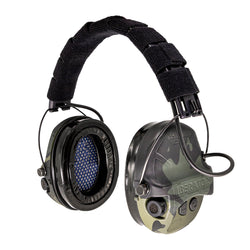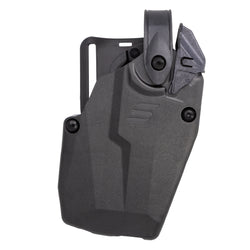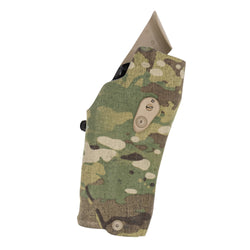Have you ever stared at all the “specs” on a flashlight and wondered what exactly they mean? On the packaging, you may see things like candela, lumens, beam distances, and strange-looking water ratings (like IPX7).
I’ll admit, even as a cop fresh out of the academy, I didn’t have a clue. Of course, I thought the higher the numbers, the better. As I read these numbers and terms, I would even nod and act impressed with the information. But ask me what they meant, and you would hear crickets.
Because I hadn’t taken the time to learn what these terms meant, my flashlight-selecting abilities were limited to assessing how cool it looked. This applied to handheld, weapon-mounted, and special-purpose lights. If the price was right and the light looked cool enough for my gear, I would assume it was a great product.
Fortunately, I was able to attend some tactical team training years later with a good instructor. He took the time to explain all the terms associated with lights and why it matters what type of light you use for different tasks.

To my surprise, there isn’t one light that is perfect for all situations. There are several factors that help dictate which light is best for specific jobs.
So, if you’re one of those people (like I was) who doesn’t understand what the terms mean, don’t worry, it’s not complicated. Here is a quick, crash course on the basics of light terminology as it relates to flashlights.
What Does Candela Mean?
Candela refers to the intensity of the flashlight beam in a specific direction. Think of candela as the concentration of light that penetrates darkness at a particular point. Higher candela ratings mean the flashlight produces a tighter, more focused beam. This intensity is perfect for illuminating distant objects or penetrating fog, smoke, or rain.

Scientifically, candela measures luminous intensity, indicating how bright the flashlight’s hotspot (the central bright spot) is. A flashlight with high candela is excellent for some tactical applications or search-and-rescue missions where pinpoint illumination is needed.
However, high candela isn’t best for all situations. For close-up tasks or general room illumination, a lower candela light provides a broader, more evenly distributed beam that’s easier on the eyes.
What Does ‘Lumens’ Mean?
Lumens measure the total amount of visible light emitted by a flashlight. Unlike candela, which gauges intensity at a single point, lumens represent overall brightness. Simply put, more lumens mean more brightness.
A high-lumen flashlight is perfect for situations requiring broad area lighting. This could include camping, outdoor activities, room clearing, or other tasks. Higher lumen counts typically mean better visibility in dark or expansive spaces.

Is the highest lumens rating always the best? No, not exactly. If you go out and buy the brightest flashlight known to man, it would be great in some situations but terrible in others.
For example, too many lumens for close-up tasks can cause glare and reduce your visibility due to excessive reflection. In simple terms, a reflection, like from a wall, can blind you momentarily. Lower lumens are preferable for tasks like reading maps, repairing machinery, or inspecting small items. Choosing the correct lumen output depends significantly on your intended application.
How is Beam Distance Estimated?
Another thing you often see listed with flashlight specs is beam distance. Beam distance is the range at which a flashlight provides usable illumination. Manufacturers typically measure beam distance based on ANSI/NEMA FL1 standards. This calculates the distance at which the flashlight’s beam intensity drops to 0.25 lux, the approximate brightness of moonlight.
Beam distance is significantly influenced by both lumens and candela. Higher candela typically means a longer beam distance because the concentrated beam travels further. Meanwhile, increasing lumens generally boosts the overall brightness, but without high candela, the beam won’t necessarily reach further distances.

If your activity requires long-distance illumination, like hunting or search-and-rescue operations, prioritize high-candela flashlights. For general home or camp use, a flashlight with moderate beam distance and balanced candela and lumens is typically a good combination.
In the photo above, I’m using the handheld Streamlight ProTac HL6, which is 5,300 lumens, 80,000 candela, and a beam distance of 566 meters.
Beam Pattern
Beam patterns refer to how the flashlight’s light is distributed. It involves the shape, spread, and intensity of the beam produced. A flashlight with a focused beam pattern, often called a “spot beam,” directs concentrated light at a single point. This provides maximum distance and clear visibility of faraway targets.
Conversely, a “flood beam” distributes light broadly, illuminating large areas uniformly. Flood beams are ideal for close-range tasks or general use, while spot beams are perfect for precise, long-distance illumination.

The beam pattern of a flashlight is determined by both the shape of the reflector or lens housing and the combination of lumens and candela. A carefully shaped reflector focuses the emitted light into a defined hotspot, while different reflector geometries and textures influence how much light spills into a broader flood area.
In the photo above, I’m using a Nebo Slyde King 2K, which is 2,000 lumens. Nebo does not list the candela, but as you can see, this light has a wide beam pattern, which means the candela is probably on the lower side.
IP Rating
Ok, the IP rating has nothing to do with light, but we’re talking about flashlights, so let’s cover it anyway.
The IP rating (Ingress Protection) measures a flashlight’s resistance to water and dust. Higher IP ratings equal better protection, which is a good thing, right?

An IP rating typically consists of two digits: the first digit indicates protection against solids like dust, while the second digit represents protection against liquids such as water.
Common water resistance ratings include:
- IPX4: Protection against water splashes from all directions.
- IPX7: Protection when submerged in water up to 1 meter for 30 minutes.
- IPX8: Protection against prolonged immersion under specified conditions, often deeper than 1 meter.
Manufacturers test these ratings through standardized procedures, including spraying the flashlight with water jets or fully submerging it under controlled conditions.
Other considerations
Once you understand more about the light itself, you can add this to your list of things to consider when selecting a light. Once you know what type of lumens, candela, and beam distance combination you need, you can look for a light that meets your other specifications.
Of course, the battery type, run time, and mounting system are also important factors when selecting a light. The bigger the battery, the longer the run-time, but the heavier or larger the light will be. You may also want to pay attention to the battery type, as some use common battery types and others do not.
If the light is a WML (weapon mounted light), the type of activation switches and mounting design are also things to consider. A large light with an M-LOK mount, for example, will not work with your handgun.
I won’t get into too much more about other factors of selecting a flashlight, as this article was more about light terminology. But hopefully, understanding this information will help you like it did me.









